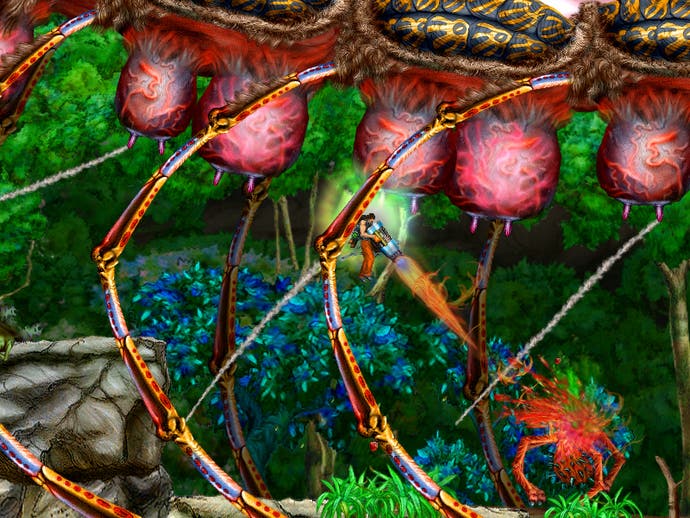Weapon of Choice
The right to choose. Guns.
If you got my fifteen-year-old self to design a game, and assuming you hadn't got me in one of my 20-sided-dice-with-everything moods, you'd end up with something which - at first glance - would look a lot like this all-action Xbox 360 Community Game.
I stress: at first glance. It wouldn't have been anywhere near as good. Not that Weapon of Choice's take on run-and-gun-isms is a modern classic, but the product of my fevered adolescent imagining would have been a big old pile of bobbins whose mechanics would barely hang together due to me spending a bit too much time thinking longingly of girls and/or the price of lead figurines and less time about the business at hand. But the obsessions and the approach... Well, it's deeply teenage.
Even it's hyperactive amateurish-yet-charming graphic style seems to have been torn-out doodles in the back of textbooks, where the only thing which could be better than giving your character an M60 machine gun would be to give him a M60 machine gun at the end of a bungie-cord. Oh, and a backpack with mechanical limbs. And something which explodes when you jump. And friends. And things which look like gonads to fight.
The obvious reference point is Contra (or, since we're Eurogamer, Gryzor), though I keep on being oddly reminded of Turrican occasionally. Moving across large levels, often with multiple paths through them, you're tasked to destroying pretty much everything. You're able to fire in any direction with the right stick, and do all the jumping, weapon-swapping and special-mode activating with the triggers and shoulder buttons. Which is all standard, until you realise your characters' abilities alter depending on who you select. Which is also all standard, until you realise that the choice is actually just for a single life.

When you die, you select another operative with their own abilities, and go in. When you run out of operatives, it's game over. You're also able to rescue operatives lost in the field, unlocking them for future playthroughs of the game or, alternatively, rescue a fallen agent who's just been killed. You'll soon have all seven characters available to pick from, and you're weighing up the relative merits between going into battle as the guy who can fly into the sky in some kind of space-snowflake and fires limpet-mines which then eject streams of flame, versus the lady who throws swarms of razor-knives and can duplicate herself mid-leap into a similarly-lacerating clone. Being able to change the way the game plays every life is one of its most attractive qualities.
Perhaps appropriately, if the main cast are one of the most charming parts, the secondary one is the antagonists, a gleefully demented cast of monsters for you to tear apart. From steadfast creatures like the floaty-eyeball things and attack-testicles, you rapidly expand into the realm of gargantuan multi-screen-wide maggots or the apes who leisurely throw their own eyeballs at you.








